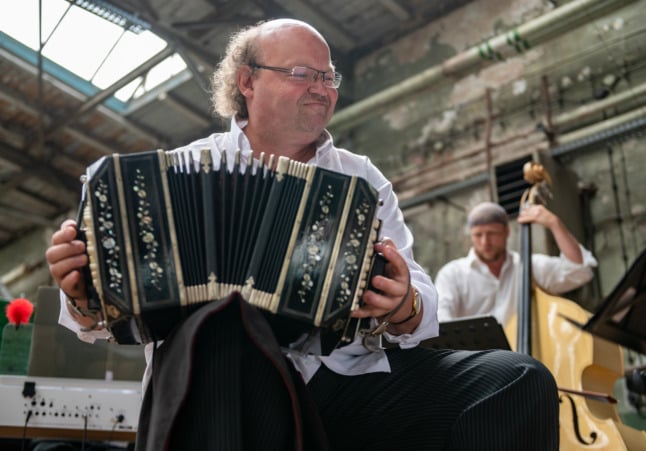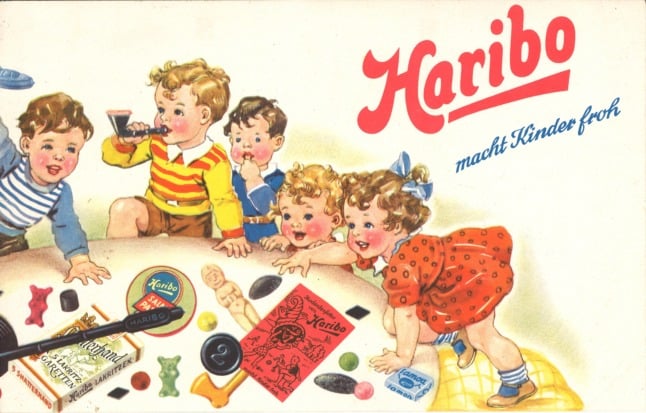Nine things you might be surprised came from Germany

You've heard of Pretzels and Laugenstangen, but German inventors have brought a lot more into the world than novelty bread shapes. Here are nine life-changing inventions you might not realise came from Germany.
Germany is well-known for its rich cultural landscape, literature, poetry and art, as well as for some of its great minds and public celebrity figures.
However, a lot of inventions which stemmed originally from Germany which not many people are aware of, ranging from centuries and centuries ago to the present day. Some of them might even surprise you.
- The fridge
Something we’re all particularly grateful for at this time of the year, you should thank Carl von Linde for this invention. An engineering professor from Berndorf, Bavaria, Linde patented the process of liquefying gas that has become essential in refrigeration technology in 1876.
He quickly developed his findings to invent the first functional and efficient compressed-ammonia refrigerator. His discovery also aided development in cryogenics, physics, chemistry and engineering.
Prior to Linde, iceboxes were used instead of refrigerators. These were insulated boxes lined with tin or zinc which held blocks of ice to keep the food cool, but had to be emptied and replaced daily.
So the next time you’re grabbing a midnight bite from your hardy, reliable refrigerator, give a thought to Linde’s efforts to make our snacking as low-maintenance as possible.
- The accordion
The accordion was supposedly invented and designed by Christian Friedrich Ludwig Buschmann in 1822, although some contest this idea as there is one earlier prototype with no attributed inventor which appears to be older.
The accordion was inspired by the Asian Sheng, which was introduced to Europe in 1777. The later German model of the accordion was quickly adopted in Russia. Russian craftsmen started producing accordions rapidly in the 1830s and 1840s.

Jürgen Karthe from the band "Carl Friedrich Tango Connection" plays his accordian in Chemnitz on July 2nd. Who would have thought we had Germany to thank for the heart-warming blare of an accordion? Photo: picture alliance/dpa/dpa-Zentralbild | Hendrik Schmidt
Buschmann, who was from Thuringia, was an instrument maker who is also sometimes credited with inventing the harmonica, although this second claim is more dubious.
If this tale does have any substance, though, Buschmann can be seen as responsible for the dulcet tones of much of the street music you might hear when walking through Munich or Nuremberg - though whether you think this is a compliment or not is up to you.
- Ear plugs
Okay, so Germans can’t technically claim to have thought up ear plugs since they feature in the ancient Greek epic, Odyssey, but the first mass-produced earplug design was produced by the German Max Negwer, who founded the company Ohropax to produce wax models.
Negwer had his fingers in a lot of different pies: he was a pharmacist, chemist and a factory owner. He received the patent for his ear plugs in 1907 and they started to be mass produced and sold in 1908.
The name ‘Ohropax’ combined the German for ‘ear’ and the Latin for ‘peace’ and exploited a growing market of Germans who professed to despise noise, associating it with the vice of the modern world.

Need a bit more quiet in your life? Germany has just the thing. Photo: picture alliance / Sebastian Gollnow/dpa | Sebastian Gollnow
In Hanover in 1907, Theodore Lessing had even founded the country’s first Antilärmverein (anti-noise society), which became a popular movement. Members of the club met to complain about the negative impact of modern noise on intellectual and cultural life.
So whether you’re using ear plugs to ensure the continued progression of cultural life or to block out your loud neighbours’ Friday night parties, we can probably all agree on the importance of Negwer’s invention.
READ ALSO: Nine things you might be surprised are actually Austrian
- The contact lens
Although the contact lens was initially theorised by the Italian Leonardo da Vinci and its first developments as an idea were led by the French René Descartes and the British Thomas Young, in the spirit of European collaboration, the first real contact lens was invented by the German ophthalmologist Adolf Gaston Eugen Fick.
Tested first on rabbits, Fick finalised the lens in 1888, although it was far from the final design as the devices could only be worn for around two hours at a time.
Nowadays contact lenses are worn by over 150 million people worldwide, either for vision correction or cosmetic purposes.
- The hole punch
The hole punch is a constant companion throughout your working life, from the most coveted item on the teacher’s desk to an admin staple at any desk job. However, not many are aware that it is a German invention, although in some ways this is not surprising given that many other Europeans associate Germans with organisation, punctuality and neatness.
Two early patents linking the first hole punching device to the Matthias Theel have been discovered, whilst Friedrich Soennecken’s patent for the first ‘Papierlocher’ (paper punch) dates back to November 1886. Both were German.
Whether you’re grateful for his innovations or not, Soennecken was a major trailblazer in modern school and office life - he also invented the ring binder and a type of pen nib. In other words, he put an awful lot of effort into helping us organise our lives.
However, the hole punch is actually a slightly contested invention. When Google decided to mark its 131st anniversary online, they received criticism after basing it on the day that Soennecken received his patent for the device, with some claiming that the American Benjamin Smith technically invented it first.
In 1885, Smith had received a US patent for a device that punched holes in train tickets, but the three-hole punch you see in offices is much closer to Soennecken’s design.
- The coffee filter
Speaking of office necessities, where would any of us be without this? The coffee filter was invented by Dresden housewife Melitta Bentz, who was frustrated by the quality of coffee produced by percolators, which left grounds in the drink and overbrewed it.
With the desperation many coffee-lovers (or addicts) will recognise when they can’t get hold of their coveted morning caffeine, Bentz experimented using the blotting paper from her children’s school books and noticed that her coffee was far less bitter and almost free of pesky grounds.
She patented the discovery and it became so successful that she even set up her own business, nowadays called ‘Melitta’ and still under the control of her family.
The method is still used today, and remains a favourite among coffee connoisseurs.
- Haribo
Haribo, the iconic brand of coloured gummy bears (called Gummibärchen in German), was invented by Hans Riegel in Bonn in 1922. He originally started making the sweets in a small kitchen with only some sugar, a marble slab, a stove and a rolling pin.
Nowadays Haribo is available in over 100 countries and produces over 100 million gummy bears per day.
And although you might know the English slogan for the bears as ‘kids and grown-ups love it so - the happy world of Haribo’, the original German catchphrase was ‘Haribo macht Kinder froh - und Erwachsene ebenso’, which translates to ‘Haribo makes children happy - and adults too’.

A 1950s Haribo advert declares that "Haribo macht Kinder froh" - and Hans Riegel's invention is still making children happy today. Oh, and adults too. Photo: picture alliance/dpa/Haribo GmbH | Haribo GmbH
The brand name Haribo is an abbreviation of HAns RIegel von BOnn.
- Bacteriology
Bacteriology is the study of bacteria’s relationship to medicine and involves the identification, classification and characterisation of bacterial species.
The German physician Robert Koch initially discovered the connection between microorganisms and disease. He discovered the bacteria that causes anthrax, septicaemia, tuberculosis and cholera, and his discoveries were key in helping others to identify other pathogens. Koch also developed many innovative new techniques in microbiology and has been a huge figure in the history of medicine.
Germany's Robert Koch Institute for disease control was named after him.
READ ALSO: Germany’s top 10 tech inventions
- The Pfizer vaccine
Just in case you weren't aware, the Covid vaccine being used in many countries around the world is half German. It was co-developed by the pharmaceutical company BioNTech, based in Mainz, and Pfizer - based in New York City.
The science of the vaccine is the work of BioNTech, particularly the company co-founders and married couple Dr Ozlem Tureci and Ugur Sahin.
The value of BioNTech has soared into the billions since the development of the Covid vaccine, and both Sahin and Tureci now number among the 100 richest people in Germany.
READ ALSO: Meet the husband-wife team behind the breakthrough Covid-19 vaccine
Comments
See Also
Germany is well-known for its rich cultural landscape, literature, poetry and art, as well as for some of its great minds and public celebrity figures.
However, a lot of inventions which stemmed originally from Germany which not many people are aware of, ranging from centuries and centuries ago to the present day. Some of them might even surprise you.
- The fridge
Something we’re all particularly grateful for at this time of the year, you should thank Carl von Linde for this invention. An engineering professor from Berndorf, Bavaria, Linde patented the process of liquefying gas that has become essential in refrigeration technology in 1876.
He quickly developed his findings to invent the first functional and efficient compressed-ammonia refrigerator. His discovery also aided development in cryogenics, physics, chemistry and engineering.
Prior to Linde, iceboxes were used instead of refrigerators. These were insulated boxes lined with tin or zinc which held blocks of ice to keep the food cool, but had to be emptied and replaced daily.
So the next time you’re grabbing a midnight bite from your hardy, reliable refrigerator, give a thought to Linde’s efforts to make our snacking as low-maintenance as possible.
- The accordion
The accordion was supposedly invented and designed by Christian Friedrich Ludwig Buschmann in 1822, although some contest this idea as there is one earlier prototype with no attributed inventor which appears to be older.
The accordion was inspired by the Asian Sheng, which was introduced to Europe in 1777. The later German model of the accordion was quickly adopted in Russia. Russian craftsmen started producing accordions rapidly in the 1830s and 1840s.

Jürgen Karthe from the band "Carl Friedrich Tango Connection" plays his accordian in Chemnitz on July 2nd. Who would have thought we had Germany to thank for the heart-warming blare of an accordion? Photo: picture alliance/dpa/dpa-Zentralbild | Hendrik Schmidt
Buschmann, who was from Thuringia, was an instrument maker who is also sometimes credited with inventing the harmonica, although this second claim is more dubious.
If this tale does have any substance, though, Buschmann can be seen as responsible for the dulcet tones of much of the street music you might hear when walking through Munich or Nuremberg - though whether you think this is a compliment or not is up to you.
- Ear plugs
Okay, so Germans can’t technically claim to have thought up ear plugs since they feature in the ancient Greek epic, Odyssey, but the first mass-produced earplug design was produced by the German Max Negwer, who founded the company Ohropax to produce wax models.
Negwer had his fingers in a lot of different pies: he was a pharmacist, chemist and a factory owner. He received the patent for his ear plugs in 1907 and they started to be mass produced and sold in 1908.
The name ‘Ohropax’ combined the German for ‘ear’ and the Latin for ‘peace’ and exploited a growing market of Germans who professed to despise noise, associating it with the vice of the modern world.

Need a bit more quiet in your life? Germany has just the thing. Photo: picture alliance / Sebastian Gollnow/dpa | Sebastian Gollnow
In Hanover in 1907, Theodore Lessing had even founded the country’s first Antilärmverein (anti-noise society), which became a popular movement. Members of the club met to complain about the negative impact of modern noise on intellectual and cultural life.
So whether you’re using ear plugs to ensure the continued progression of cultural life or to block out your loud neighbours’ Friday night parties, we can probably all agree on the importance of Negwer’s invention.
READ ALSO: Nine things you might be surprised are actually Austrian
- The contact lens
Although the contact lens was initially theorised by the Italian Leonardo da Vinci and its first developments as an idea were led by the French René Descartes and the British Thomas Young, in the spirit of European collaboration, the first real contact lens was invented by the German ophthalmologist Adolf Gaston Eugen Fick.
Tested first on rabbits, Fick finalised the lens in 1888, although it was far from the final design as the devices could only be worn for around two hours at a time.
Nowadays contact lenses are worn by over 150 million people worldwide, either for vision correction or cosmetic purposes.
- The hole punch
The hole punch is a constant companion throughout your working life, from the most coveted item on the teacher’s desk to an admin staple at any desk job. However, not many are aware that it is a German invention, although in some ways this is not surprising given that many other Europeans associate Germans with organisation, punctuality and neatness.
Two early patents linking the first hole punching device to the Matthias Theel have been discovered, whilst Friedrich Soennecken’s patent for the first ‘Papierlocher’ (paper punch) dates back to November 1886. Both were German.
Whether you’re grateful for his innovations or not, Soennecken was a major trailblazer in modern school and office life - he also invented the ring binder and a type of pen nib. In other words, he put an awful lot of effort into helping us organise our lives.
However, the hole punch is actually a slightly contested invention. When Google decided to mark its 131st anniversary online, they received criticism after basing it on the day that Soennecken received his patent for the device, with some claiming that the American Benjamin Smith technically invented it first.
In 1885, Smith had received a US patent for a device that punched holes in train tickets, but the three-hole punch you see in offices is much closer to Soennecken’s design.
- The coffee filter
Speaking of office necessities, where would any of us be without this? The coffee filter was invented by Dresden housewife Melitta Bentz, who was frustrated by the quality of coffee produced by percolators, which left grounds in the drink and overbrewed it.
With the desperation many coffee-lovers (or addicts) will recognise when they can’t get hold of their coveted morning caffeine, Bentz experimented using the blotting paper from her children’s school books and noticed that her coffee was far less bitter and almost free of pesky grounds.
She patented the discovery and it became so successful that she even set up her own business, nowadays called ‘Melitta’ and still under the control of her family.
The method is still used today, and remains a favourite among coffee connoisseurs.
- Haribo
Haribo, the iconic brand of coloured gummy bears (called Gummibärchen in German), was invented by Hans Riegel in Bonn in 1922. He originally started making the sweets in a small kitchen with only some sugar, a marble slab, a stove and a rolling pin.
Nowadays Haribo is available in over 100 countries and produces over 100 million gummy bears per day.
And although you might know the English slogan for the bears as ‘kids and grown-ups love it so - the happy world of Haribo’, the original German catchphrase was ‘Haribo macht Kinder froh - und Erwachsene ebenso’, which translates to ‘Haribo makes children happy - and adults too’.

A 1950s Haribo advert declares that "Haribo macht Kinder froh" - and Hans Riegel's invention is still making children happy today. Oh, and adults too. Photo: picture alliance/dpa/Haribo GmbH | Haribo GmbH
The brand name Haribo is an abbreviation of HAns RIegel von BOnn.
- Bacteriology
Bacteriology is the study of bacteria’s relationship to medicine and involves the identification, classification and characterisation of bacterial species.
The German physician Robert Koch initially discovered the connection between microorganisms and disease. He discovered the bacteria that causes anthrax, septicaemia, tuberculosis and cholera, and his discoveries were key in helping others to identify other pathogens. Koch also developed many innovative new techniques in microbiology and has been a huge figure in the history of medicine.
Germany's Robert Koch Institute for disease control was named after him.
READ ALSO: Germany’s top 10 tech inventions
- The Pfizer vaccine
Just in case you weren't aware, the Covid vaccine being used in many countries around the world is half German. It was co-developed by the pharmaceutical company BioNTech, based in Mainz, and Pfizer - based in New York City.
The science of the vaccine is the work of BioNTech, particularly the company co-founders and married couple Dr Ozlem Tureci and Ugur Sahin.
The value of BioNTech has soared into the billions since the development of the Covid vaccine, and both Sahin and Tureci now number among the 100 richest people in Germany.
READ ALSO: Meet the husband-wife team behind the breakthrough Covid-19 vaccine
Join the conversation in our comments section below. Share your own views and experience and if you have a question or suggestion for our journalists then email us at [email protected].
Please keep comments civil, constructive and on topic – and make sure to read our terms of use before getting involved.
Please log in here to leave a comment.